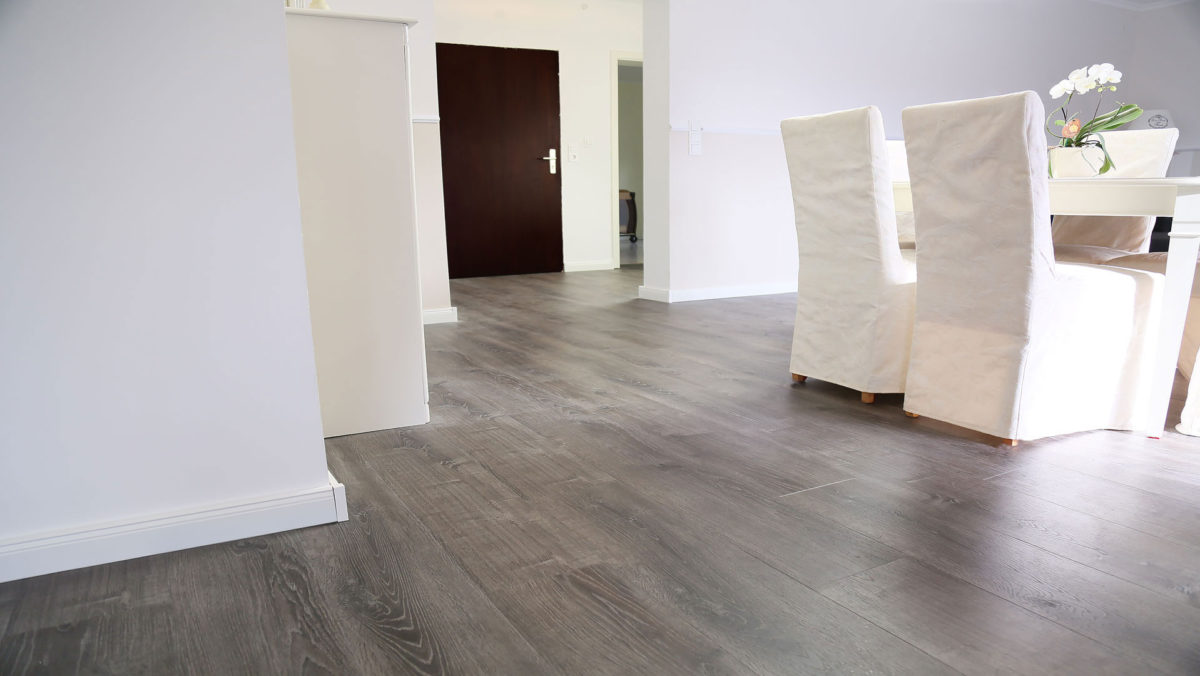
Today, we show you how to lay a vinyl floor almost completely through a space without using an expansion joint. This situation could occur in many houses or apartments: a living room and a hallway with an adjoining entrance area are to be laid with the same flooring throughout. By paying attention to a few essential details, this can be quite successful with a planeo plank. Moreover, it's visually appealing when no interruption disturbs the appearance of the floor decor.
Content
Skillful transition to the next room
The floor areas of the hallway and living room are to be laid in one piece. Additionally, the vinyl flooring on one side in the hallway will meet a tile edge with a slight height difference. The entire vinyl area is to be realized without an expansion joint, which would otherwise need to be equipped with a cover strip in the passageway area. With planeo planks, this can be well resolved, as they can be laid in both directions.
The floor area of the living room is almost completely finished with the new vinyl. The area approaches the passage to the hallway. The existing door cutout here will remain free. There will be no frame or door installed. To work without an interruption in the form of a joint or strip, the vinyl flooring will be laid piece by piece through the door hole into the adjoining hallway, in the usual manner. We have already captured this procedure in another video for you.
The vinyl planks are first inserted with the short side into the already lying plank. Then, the long side with the narrow tongue is placed at the plank and the click connection is sealed with light taps using a mallet. Generally, when laying vinyl floors, it is always necessary to work with a sufficient distance from the wall. Especially important: when rebuilding a door cutout or passageway area, a perimeter gap of about 10 to 15 mm should be maintained. It is advised against placing the plank directly against the wall. Especially since the installation area will later be neatly finished along the walls with a skirting board.
Installation in both directions: forward and back
Once the first planks in the transition between one room and the adjoining area are laid, the installation continues in both directions from this point. The vinyl area previously started in the living room will be continued in the usual direction in the hallway. Starting from the transition element, the hallway area will literally be laid 'in reverse'.
This is special because the planks, when laid in the opposite direction, need to be handled slightly differently. Now, take the sides of the plank with the wide tongues, i.e., click elements, and connect them to the already laid element. Hold the plank with the wide click tongue on the long side towards you and insert it into the previous row. You will notice that the board must be angled slightly differently. The wider tongue requires a different kind of pressure when inserting it into the installation surface. Even then, the vinyl plank is first inserted with the short side, the end side, into the previous element.
When inserting the long side of the plank, it is advisable to use a gentle rocking motion. Then slightly lift the row of planks and seal the connection between the individual elements as usual with the mallet. Please be careful to ensure that the click connection does not become misaligned.
If you have any questions, please feel free to contact us. We provide professional advice for a smooth workflow. We also share special tricks with you. We look forward to your project and have a variety of solutions ready for you.
Experience the best service with planeo - because you need it!
No matter what challenges you face with your project, planeo provides you with the right solution. Benefit from the advantages of our services:
- Free samples for many of our products: Order up to 7 samples at no cost, for instance, of our vinyl floors, click vinyl, adhesive vinyl, or rigid vinyl.
- Express delivery - for urgent projects and quick decisions.
- Expert advice - We offer professional consultation through our contact page or answer your questions directly in the comments.